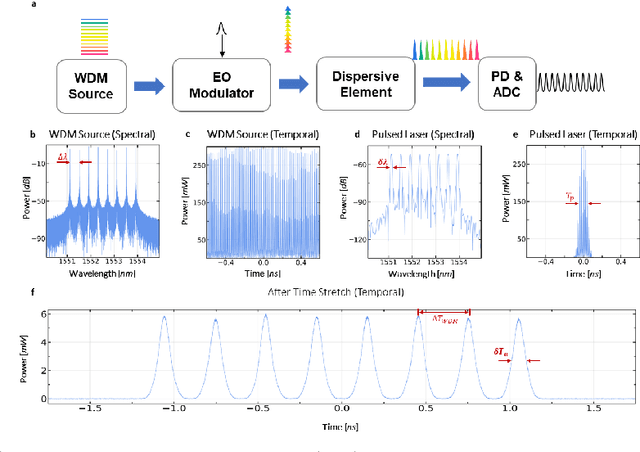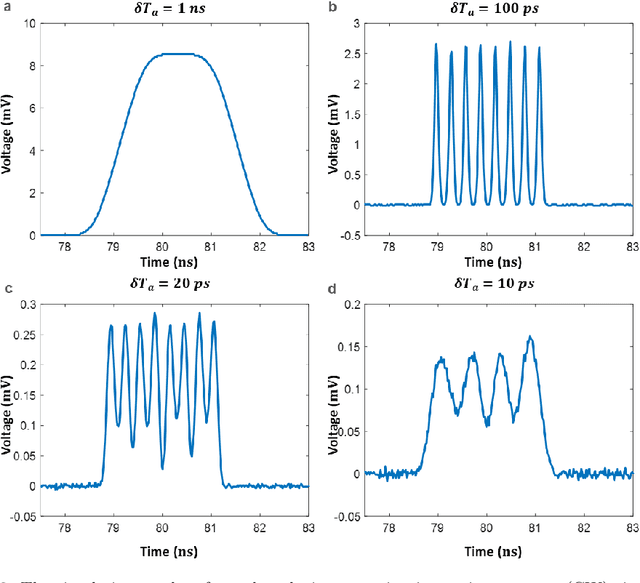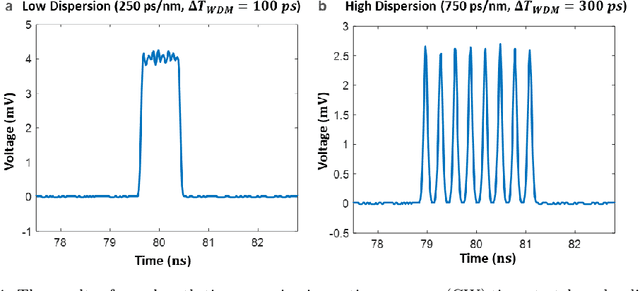Hideaki Furukawa
Time Stretch with Continuous-Wave Lasers for Practical Fast Realtime Measurements
Sep 19, 2023



Abstract:Realtime high-throughput sensing and detection enables the capture of rare events within sub-picosecond time scale, which makes it possible for scientists to uncover the mystery of ultrafast physical processes. Photonic time stretch is one of the most successful approaches that utilize the ultra-wide bandwidth of mode-locked laser for detecting ultrafast signal. Though powerful, it relies on supercontinuum mode-locked laser source, which is expensive and difficult to integrate. This greatly limits the application of this technology. Here we propose a novel Continuous Wave (CW) implementation of the photonic time stretch. Instead of a supercontinuum mode-locked laser, a wavelength division multiplexed (WDM) CW laser, pulsed by electro-optic (EO) modulation, is adopted as the laser source. This opens up the possibility for low-cost integrated time stretch systems. This new approach is validated via both simulation and experiment. Two scenarios for potential application are also described.
Real-time Transmission of Geometrically-shaped Signals using a Software-defined GPU-based Optical Receiver
Aug 16, 2021



Abstract:A software-defined optical receiver is implemented on an off-the-shelf commercial graphics processing unit (GPU). The receiver provides real-time signal processing functionality to process 1 GBaud minimum phase (MP) 4-, 8-, 16-, 32-, 64-, 128-ary quadrature amplitude modulation (QAM) as well as geometrically shaped (GS) 8- and 128-QAM signals using Kramers-Kronig (KK) coherent detection. Experimental validation of this receiver over a 91 km field-deployed optical fiber link between two Tokyo locations is shown with detailed optical signal-to-noise ratio (OSNR) investigations. A net data rate of 5 Gbps using 64-QAM is demonstrated.
Real-time 10,000 km Straight-line Transmission using a Software-defined GPU-Based Receiver
Aug 16, 2021



Abstract:Real-time 10,000 km transmission over a straight-line link is achieved using a software-defined multi-modulation format receiver implemented on a commercial off-the-shelf general-purpose graphics processing unit (GPU). Minimum phase 1 GBaud 4-ary quadrature amplitude modulation (QAM) signals are transmitted over 10,000 km and successfully received after detection with a Kramers-Kronig (KK) coherent receiver. 8-, 16-, 32-, and 64-QAM are successfully transmitted over 7600, 5600, 3600, and 1600 km, respectively.
10,000 km Straight-line Transmission using a Real-time Software-defined GPU-Based Receiver
Apr 08, 2021Abstract:Real-time operation of a software-defined, GPU-based optical receiver is demonstrated over a 100-span straight-line optical link. Performance of minimum-phase Kramers-Kronig 4-, 8-, 16-, 32-, and 64-QAM signals are evaluated at various distances.
 Add to Chrome
Add to Chrome Add to Firefox
Add to Firefox Add to Edge
Add to Edge